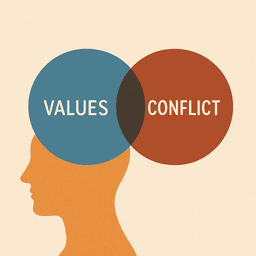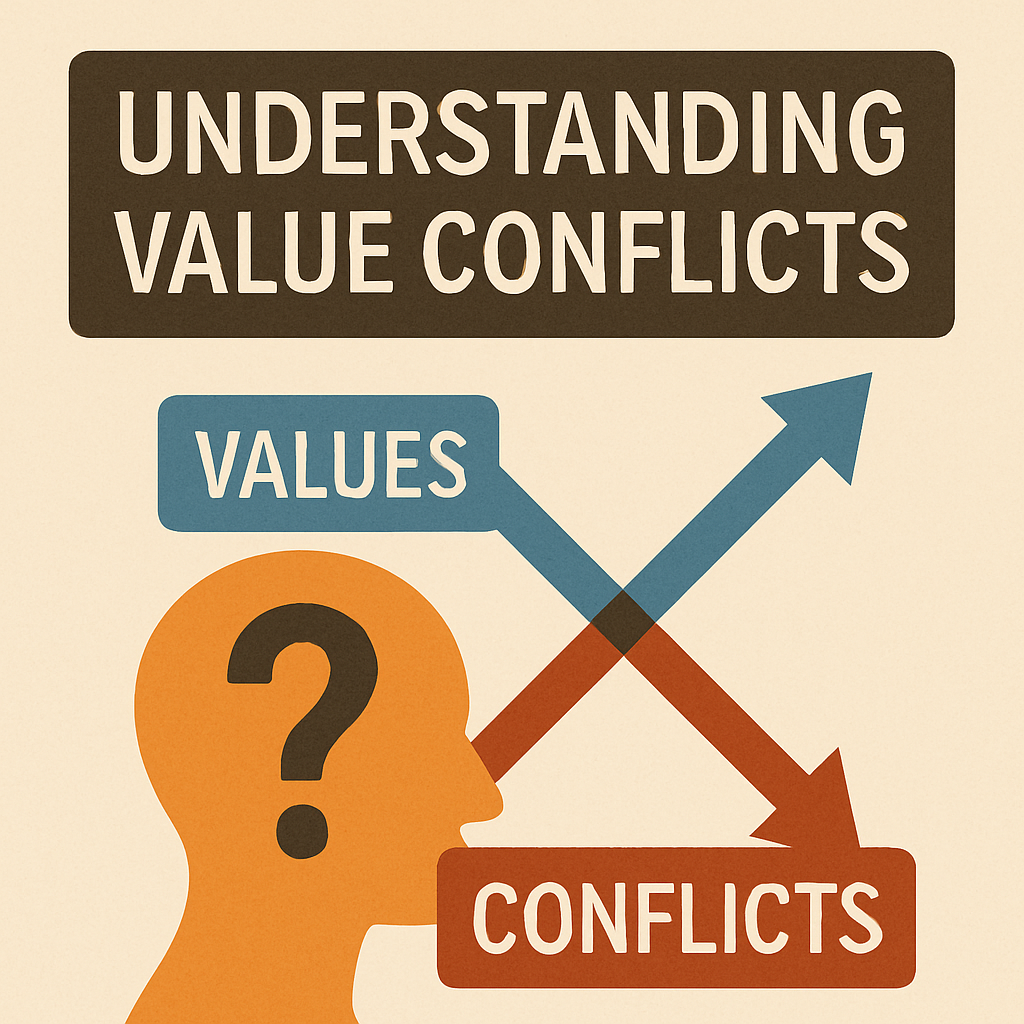
What Happens When Your Values Conflict
🎧 Prefer listening? Play the narrated version below.
1. When Your Inner Compass Splits in Two
Most of us like to believe that our values — the principles that define who we are — always point in the same direction. We imagine them as a clear compass guiding us toward the right decisions and a meaningful life. But what happens when two of your most important values start pulling you in opposite directions?
Maybe you deeply value honesty, but you also care about kindness — and now you’re facing a situation where telling the truth might hurt someone you love. Or perhaps you value freedom, yet also crave security, and you’re torn between quitting a stable job or pursuing a risky dream.
These aren’t just abstract moral puzzles. They’re the quiet internal battles that shape your relationships, career choices, and sense of peace. When your values clash, you don’t just face a hard decision — you experience a deep tension between competing parts of yourself. It can feel like your mind says one thing, your heart another, and no matter what you choose, you’re betraying something essential.
Value conflicts are among the most profound sources of personal stress. They can make even simple decisions exhausting, trigger guilt or indecision, and leave you questioning who you really are. Yet they’re also powerful opportunities — signs that you’re evolving, that your understanding of what matters most is growing more complex.
In this article, we’ll explore why value conflicts happen, what they reveal about you, and how to navigate them with clarity and integrity. You’ll learn how to recognize when your values are colliding, how to resolve or integrate them, and how to turn inner conflict into self-alignment and growth.

2. Understanding Value Conflicts
At first glance, our values seem like they should all work together — honesty, kindness, freedom, loyalty, integrity, love, growth. Each sounds positive on its own. But the reality of human life is far more nuanced: our values don’t exist in isolation. They interact, compete for attention, and sometimes collide.
A value conflict occurs when two (or more) of your deeply held principles pull you in different directions. Both feel right — but they demand opposite actions. This isn’t about “good vs. bad”; it’s about “good vs. good.” And that’s what makes it so difficult.
Imagine you value success and family. Pursuing career advancement may require long hours and travel, which means missing time with your children. Or perhaps you value independence, yet you also crave connection — you want freedom to make your own choices, but fear losing closeness with your partner if you do. In these moments, there’s no simple solution. You’re not failing to live your values — your values are simply in tension.
There are three main types of value conflicts you’re likely to encounter:
- Internal Conflicts — when two personal values within you compete.
Example: “I value honesty, but I also value harmony — do I speak up or stay silent?”
- Interpersonal Conflicts — when your values clash with someone else’s.
Example: “I value fairness, my manager values efficiency — and our decisions reflect that difference.”
- Systemic Conflicts — when your personal values collide with the culture or structure around you.
Example: “I value transparency, but my workplace rewards secrecy and control.”
Recognizing which type of conflict you’re facing is the first step toward clarity. Often, the real tension isn’t about the situation itself but about what it threatens inside you — your sense of identity, safety, or belonging.
Understanding this helps reframe the conflict not as a problem to eliminate, but as an opportunity to refine what each value truly means to you — and to learn how they can coexist, even if imperfectly.

3. Why Value Conflicts Hurt So Much
When two of your core values clash, the pain isn’t just mental — it’s emotional, even physical. You might feel restless, anxious, heavy in your chest, or mentally exhausted. That’s because a value conflict isn’t just a decision problem. It’s an identity problem.
Our values form the architecture of who we are. They define what we stand for, how we make sense of the world, and what gives our lives meaning. So when two of them collide, it’s as if two parts of yourself are fighting for control — both convinced they’re protecting your integrity.
Your brain interprets this tension as cognitive dissonance — a state where two beliefs or motivations contradict each other. The prefrontal cortex (responsible for reasoning) and the limbic system (which processes emotion) send competing signals. One urges you to act according to one value; the other resists because it violates another. The result is an internal tug-of-war that drains mental energy and triggers stress responses — cortisol spikes, muscle tension, racing thoughts.
This is why you might feel torn, paralyzed, or guilty no matter what you choose. You’re not indecisive — you’re trying to stay true to yourself on multiple levels at once.
On a deeper level, value conflicts can shake your sense of coherence — the feeling that your actions and beliefs form a consistent, meaningful whole. When coherence breaks down, you start to question: “Who am I really?” or “Why can’t I just decide?” That’s why these conflicts can feel more distressing than external problems like finances or deadlines. They reach into the core of self-definition.
But here’s the good news: that discomfort has a purpose. Psychologically, tension between values is often a signal of growth. It means your priorities are evolving, your understanding of life is deepening, and your system of values is being refined. In other words, conflict often arises at the boundary between who you were and who you’re becoming.
Rather than trying to silence the pain, it’s more useful to listen to it. Ask yourself what each side of the conflict is trying to protect. Often, both are guarding something precious — and recognizing that is the first step toward resolution and self-alignment.
4. Common Real-Life Examples of Conflicting Values
Value conflicts don’t just appear in theory — they play out quietly in everyday choices. They shape the arguments you have with your partner, the doubts you feel at work, and the guilt that keeps you awake at night. Recognizing these patterns helps you see that inner tension isn’t a sign of weakness — it’s a sign of being human.
Here are some of the most common examples of value conflicts and how they show up in real life:
1. Achievement vs. Family
Values in conflict: Achievement vs. Family
You want to provide for your family and grow professionally — but that ambition often means missing family dinners or skipping your child’s recital. You feel proud of your work, yet guilty about your absence.
Typical trap: Telling yourself “It’s just temporary” — while the conflict becomes a permanent emotional drain.
2. Honesty vs. Kindness
Values in conflict: Honesty vs. Kindness
You believe in being truthful, but you also don’t want to hurt someone’s feelings. Do you tell your friend their project isn’t working, or protect their confidence?
Typical trap: Sugarcoating or avoiding hard conversations — which preserves harmony in the short term but builds resentment underneath.
3. Freedom vs. Security
Values in conflict: Freedom vs. Security
You dream of quitting your job to start something of your own, but the thought of losing financial stability feels terrifying.
Typical trap: Staying “on the fence” — never taking the leap, but never feeling settled where you are.
4. Loyalty vs. Authenticity
Values in conflict: Loyalty vs. Authenticity
You feel loyal to your team or organization, yet some of their practices don’t sit right with your ethics. Do you speak up and risk rejection, or stay silent and compromise your integrity?
Typical trap: Rationalizing inaction with phrases like “It’s not my place” — slowly dulling your moral sensitivity.
5. Growth vs. Health
Values in conflict: Growth vs. Health
You value excellence and achievement, but constant pressure leaves you drained and anxious.
Typical trap: Believing burnout is “the price of success” — forgetting that sustainable growth requires balance.
6. Independence vs. Love
Values in conflict: Independence vs. Love
You cherish your freedom, but your partner craves closeness. Each of you feels misunderstood — one feels controlled, the other feels neglected.
Typical trap: Seeing the other person as the “problem” instead of realizing you’re both defending valid values.
These examples reveal a key truth: most inner conflicts aren’t about choosing right or wrong — they’re about managing two rights. Once you recognize the pattern behind your tension, you can start asking better questions — not “Which value wins?”, but “How can both have a voice in my life?”

5. How to Identify When a Value Conflict Is Happening
Not every tough decision means your values are in conflict. Sometimes it’s just inconvenience or fear of change. But when your mind feels split and your emotions pull in opposite directions, it’s usually something deeper — a clash between two parts of what you hold sacred.
Here’s how to recognize when a value conflict is truly happening:
Signs You’re Caught Between Competing Values
- You feel torn no matter what you choose. Each option feels like a loss — as if choosing one part of yourself means betraying another.
- You experience guilt from both sides. You can’t win emotionally. Even after deciding, you still replay the scenario in your head, doubting if it was “the right thing.”
- You rationalize one choice but emotionally resist it. Your logic says it makes sense, but your body tightens, your sleep suffers, or you can’t shake a subtle unease.
- You overanalyze or delay decisions. You search endlessly for the “perfect” option that satisfies every value — and end up stuck in limbo.
- You feel disconnected from yourself. You may notice thoughts like “I don’t even know what I want anymore” or “I feel fake when I do this.”
- You keep seeking external validation. You ask others what they’d do — not for advice, but because your internal compass feels scrambled.
Self-Reflection Prompt
Take a quiet moment and write down your top 5 values — the ones that matter most to you right now. Now ask yourself:
“Which two of these feel like they’re pulling in opposite directions in my life at the moment?”
Circle those two and describe what each one wants for you. For example:
- Freedom wants me to feel unrestricted and spontaneous.
- Security wants me to feel safe and prepared.
Often, simply naming the tension brings immediate relief. You’re no longer just confused — you’re witnessing a dialogue between two legitimate parts of yourself.
Quick Check: Is This Really a Value Conflict?
Ask:
- Is this about what’s right for me — or just what’s comfortable?
- Am I choosing between two meaningful ideals, or between a value and a fear?
If both sides represent genuine values — not just comfort vs. discomfort — then you’re facing a true inner conflict. And that’s good news: it means your life is presenting a chance to grow in self-awareness and integrity.

6. The Hidden Message Behind Conflicting Values
At first, a value conflict feels like something has gone wrong — as if you’ve failed to stay true to yourself. But in reality, it’s often a sign that something is evolving within you. Your values haven’t stopped working — they’re just asking for an update.
Values aren’t static rules written in stone. They’re living priorities that adapt as your life changes. What felt essential five years ago may not carry the same weight today — not because it lost meaning, but because you’ve grown. A value conflict is one of the clearest signs that this growth is happening.
A Conflict Is a Signal, Not a Mistake
When two values clash — like freedom vs. security, or honesty vs. harmony — it means both still matter deeply to you. The discomfort isn’t punishment; it’s feedback. It tells you: “There’s more complexity here than before. You’re being invited to expand your understanding of what these values mean.”
In other words, the tension is asking you to move from either/or thinking toward both/and integration. Instead of asking, “Should I choose freedom or security?”, the better question is, “How can I experience freedom within security?” This shift turns conflict into creativity.
When Values Ask to Be Redefined
Sometimes, the meaning you’ve attached to a value is too narrow. For example:
- You might define success only as external recognition, while your deeper need is mastery or contribution.
- You might define love as self-sacrifice, when what you actually crave is mutual respect.
- You might equate honesty with bluntness, instead of truth spoken with care.
When life brings these contradictions to the surface, it’s not exposing your flaws — it’s showing you where your definitions have become outdated.
Growth Through Integration
Mature alignment doesn’t mean you’ll never feel torn again. It means you learn to hold two truths at once. You begin to see that loyalty and integrity can coexist; that ambition and rest can support each other; that compassion and truth can live in the same sentence.
As one philosopher put it:
“When two values conflict, it’s not that one is wrong — it’s that life is asking you to become big enough to hold both.”
That’s the hidden message behind every value conflict: your life isn’t breaking apart — it’s stretching, so you can become more whole.

7. Framework: How to Resolve a Value Conflict
Understanding that your values are in tension is only the first step. The next challenge is learning how to work with that tension — not by suppressing one value, but by finding a way for both to coexist or by consciously deciding which one leads in this moment.
Below is a practical five-step framework to help you move from confusion to clarity. It’s not about finding a perfect answer — it’s about finding an honest one.
Step 1: Name the Conflict Clearly
Most people skip this step. They describe their situation (“I don’t know whether to quit my job”) but not the values underneath (“I value freedom, but I also value stability”). Clarity begins when you give each side a name.
Try this formula:
“I value _, but I also value _, and right now they seem to be in conflict.”
Example: “I value honesty, but I also value kindness — and telling the full truth might hurt someone I care about.”
Once you name it, the fog lifts. It’s no longer an emotional blur — it’s a dialogue between two important voices.
Step 2: Define What Each Value Truly Means
Ask yourself what each value represents for you personally, not abstractly. What does “freedom” mean to you? Is it flexibility, self-expression, or control over your time? What does “security” mean — financial safety, predictability, belonging?
Many conflicts fade once you realize your definitions were too rigid. Sometimes, the two values aren’t enemies — they’re just speaking different languages.
Example:
- Freedom = “having options.”
- Security = “knowing I can handle whatever comes.”
These can actually support each other.
Step 3: Explore the Need Behind Each Value
Every value protects a deeper emotional need — safety, love, respect, meaning, peace. When you connect with that need, the tension softens. You see that both sides are trying to serve you in their own way.
Ask:
- What is this value trying to give me?
- What am I afraid would happen if I ignored it?
Example: Freedom wants autonomy and self-trust.
Security wants predictability and peace of mind.
Both are trying to keep you safe — just in different ways.
Step 4: Find Integration or Hierarchy
Now that you understand both sides, you can choose your path: integration or hierarchy.
- Integration means creating a new perspective where both values coexist.
Example: Instead of choosing between freedom and security, you build a life that has both — maybe freelancing with a financial safety net, or setting flexible routines that provide structure without rigidity.
- Hierarchy means consciously deciding which value will lead for now, knowing you’re not abandoning the other.
Example: “Right now, I’ll prioritize family over career growth — because this season of life calls for it.”
Both approaches are valid. The power lies in deciding intentionally, not reactively.
Step 5: Act with Awareness (and Compassion)
Once you’ve reached clarity, act — but gently.
You might still feel guilt or fear; that’s normal. Acting with awareness means saying to yourself: “I know what I’m choosing, and I accept the trade-off.”
Every decision expresses a hierarchy of values — but when you choose consciously, the tension transforms into peace. You’re not betraying yourself; you’re aligning with your truth as you understand it today.
Example:
You tell your friend the difficult truth — not bluntly, but with care.
You’ve honored honesty and kindness at once. The conflict hasn’t disappeared — it’s been integrated.
Resolving value conflicts isn’t about perfection; it’s about integrity — the ability to stay whole even when life pulls you in different directions. Each time you face such a conflict consciously, you strengthen that integrity. You become someone who doesn’t run from inner tension, but uses it as a compass for growth.

8. When Value Conflicts Don’t Resolve Easily
Sometimes, even after reflection and honest effort, a value conflict doesn’t neatly resolve. You understand both sides, you’ve looked for integration — yet the tension remains. That’s not a failure. It’s a sign that you’re dealing with a chronic or structural conflict — one that may not be fully under your control.
1. When the Environment Is the Source
Some conflicts persist because they’re baked into the systems you live or work in.
For example:
- You value transparency, but your company rewards secrecy.
- You value compassion, but your industry prizes competition.
- You value authenticity, but your social circle avoids vulnerability.
In such cases, no amount of personal reflection will completely dissolve the tension — because the context itself enforces the conflict. That’s when awareness becomes a tool for strategy rather than self-blame. You can ask:
“Is this environment aligned with the person I’m becoming — or is it constantly forcing me to compromise my core values?”
If the answer is the latter, the most honest resolution may be changing the system or leaving it.
2. When People You Love Have Different Values
Interpersonal conflicts of values are especially hard, because love or loyalty tie you to someone who sees the world differently. A partner might value stability while you value adventure. A parent might prize tradition while you crave independence.
These aren’t just opinion differences — they touch identity. The key isn’t to “win,” but to build mutual respect for the difference itself.
Instead of trying to convert the other person, you can agree on shared meta-values — like kindness, honesty, or curiosity — that help you navigate the friction. In other words, you may not share the same values, but you can share how you treat each other when those values clash.
3. When the Conflict Lives Inside You
Sometimes, the hardest conflicts are the ones that reflect internal fragmentation — two parts of you that evolved under different circumstances. Perhaps one part learned to value achievement to earn love, while another craves rest and peace. You can’t just “pick one.” You have to build dialogue between them.
Therapeutic or reflective tools like journaling, coaching, or inner parts work (e.g. Internal Family Systems) can help you listen to those inner voices without judgment. Each one developed to protect you — understanding that turns guilt into compassion.
4. When You Have to Live With the Tension
Some value conflicts aren’t meant to be solved — only managed.
A doctor may always struggle between compassion and detachment.
A leader may always balance honesty with diplomacy.
A parent may always weigh freedom against safety.
In these cases, the goal isn’t elimination of tension, but skillful navigation — learning to live in the gray zone without losing yourself. The presence of tension doesn’t mean something is wrong with you; it means you care deeply about more than one truth.
If you’re facing a value conflict that doesn’t resolve, remember: you can live in peace even without full clarity — as long as you stay conscious and kind toward yourself. Integrity isn’t about perfect alignment; it’s about remaining honest in the midst of contradiction.
Sometimes, the wisest thing you can do is stop demanding a clean answer, and start cultivating the strength to live gracefully in between.

9. Realignment in Action: Turning Conflict into Clarity
Once you’ve recognized, explored, and even lived through a value conflict, the real work begins — realignment. This is the process of taking what you’ve learned from the tension and consciously adjusting your beliefs, behaviors, or priorities so they reflect who you are now, not who you were in the past.
1. Reflection Without Action Keeps You Stuck
Awareness alone is powerful, but it’s not enough. You can understand your conflict deeply and still feel lost if you don’t act on that insight. Realignment means bringing your behavior back in line with your truth — even through small, consistent steps.
Ask yourself:
“What would it look like if my daily actions reflected the lessons I’ve learned from this conflict?”
For example:
- If your conflict was between achievement and health, maybe realignment means saying no to an extra project and using that time for recovery.
- If it was between freedom and stability, maybe it means setting boundaries that preserve flexibility without chaos.
Every small, embodied choice builds a new kind of harmony.
2. Reassess Your Value Hierarchy Regularly
Your values aren’t permanent fixtures; they’re dynamic priorities that shift with life’s seasons. A conflict often signals that your inner hierarchy needs an update.
You can perform a simple “values audit” every few months by asking:
- Which values currently feel most alive in me?
- Which ones feel neglected or outdated?
- Where do I feel tension or guilt — and what might that be teaching me?
Treat this process like fine-tuning an instrument — not tearing apart a system, but restoring balance.
3. Use Tools to Track Your Evolution
One of the most effective ways to stay aligned is to make your values visible and measurable. Writing them down, journaling about decisions, or using tools like personalvalu.es lets you see how your priorities evolve over time.
By revisiting your results periodically, you might notice that what once was your top value has gracefully stepped aside for another — and that’s not inconsistency. That’s growth. Awareness transforms conflict into clarity by revealing the direction your life naturally wants to move toward.
4. Integrate, Don’t Erase
You don’t have to abandon the “losing” value in a conflict. Often, it still deserves a place — just in a different role. If freedom led you to change jobs, security can still guide how you manage your finances. If honesty prompted a tough conversation, kindness can guide how you follow up afterward.
True alignment isn’t about elimination; it’s about integration — creating a life where your values complement rather than compete.
5. Realignment as a Lifelong Practice
Life will keep presenting new tensions, because growth means continually refining what matters. Each conflict is like a calibration point, helping you re-center around your evolving sense of purpose.
You’ll never “solve” your values once and for all — and that’s a good thing. Your capacity to realign again and again is what makes you resilient, adaptive, and authentic.
Try this: Revisit your Personal Values profile once or twice a year. Notice which values rise, which fade, and which stay constant. Each shift tells a story about who you’re becoming — and that story deserves your attention.
10. Growth Through Tension
When your values collide, it can feel like something inside you is breaking apart. But if you look closer, you’ll see something deeper is actually coming together — a truer, wiser version of yourself.
Conflict between values isn’t a sign that you’re lost; it’s proof that you’re alive, evolving, and capable of holding more than one truth at a time. It’s what happens when your inner world outgrows the simple definitions that used to fit.
Every clash between values — freedom vs. security, truth vs. kindness, ambition vs. rest — invites you to grow in nuance, empathy, and integrity. It’s not about “winning” one side. It’s about learning how to stay whole while life stretches you between them.
There’s no finish line for alignment. It’s a living practice — an ongoing conversation between who you were, who you are, and who you’re becoming. Some days, the dialogue is peaceful; other days, it’s messy and loud. But if you keep listening with honesty and compassion, you’ll always find your way back to center.
So when you next feel torn, pause before rushing to “fix” the discomfort. Ask instead:
“What part of me is trying to grow through this?”
That question turns pain into guidance. It transforms inner conflict into clarity — and tension into transformation.
Because in the end, the goal isn’t to have a life without conflict. It’s to have a life rich enough in meaning that your values keep challenging you to become more fully yourself.
If you’d like to explore where your own values may be in tension — and how they’re evolving — take the free values assessment at personalvalu.es. Awareness is the first step toward alignment.